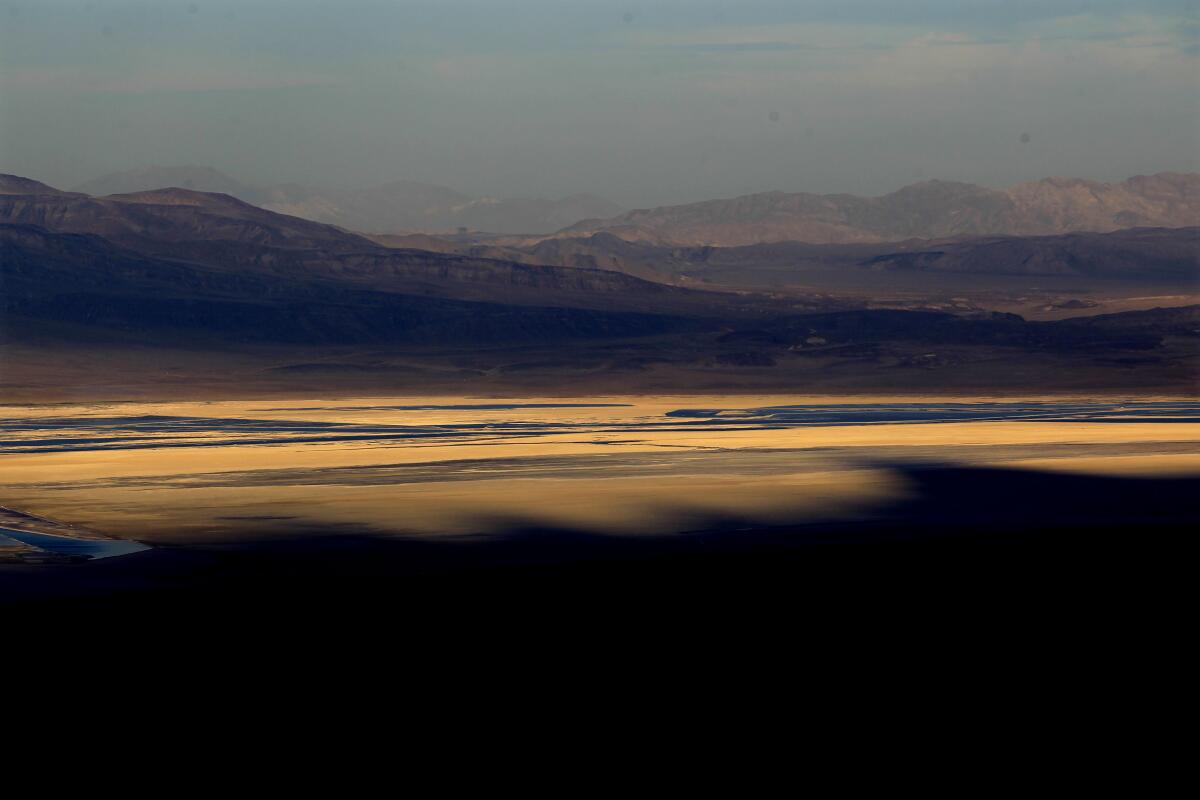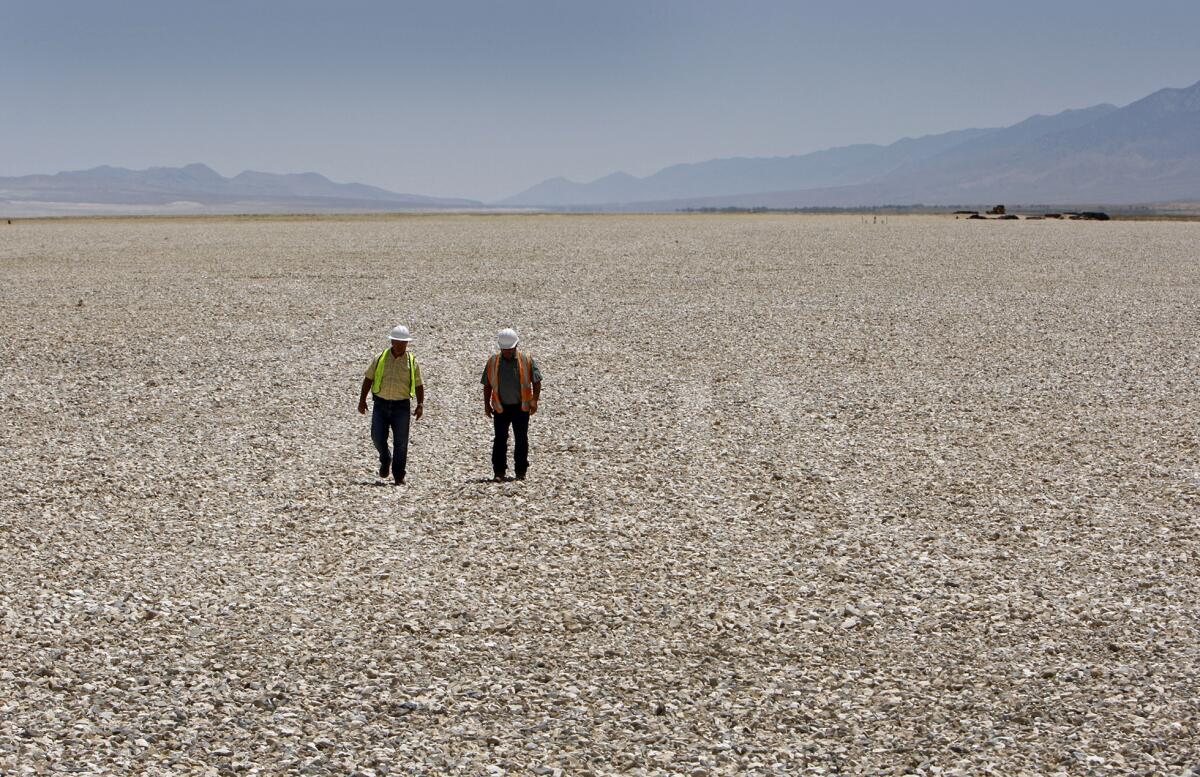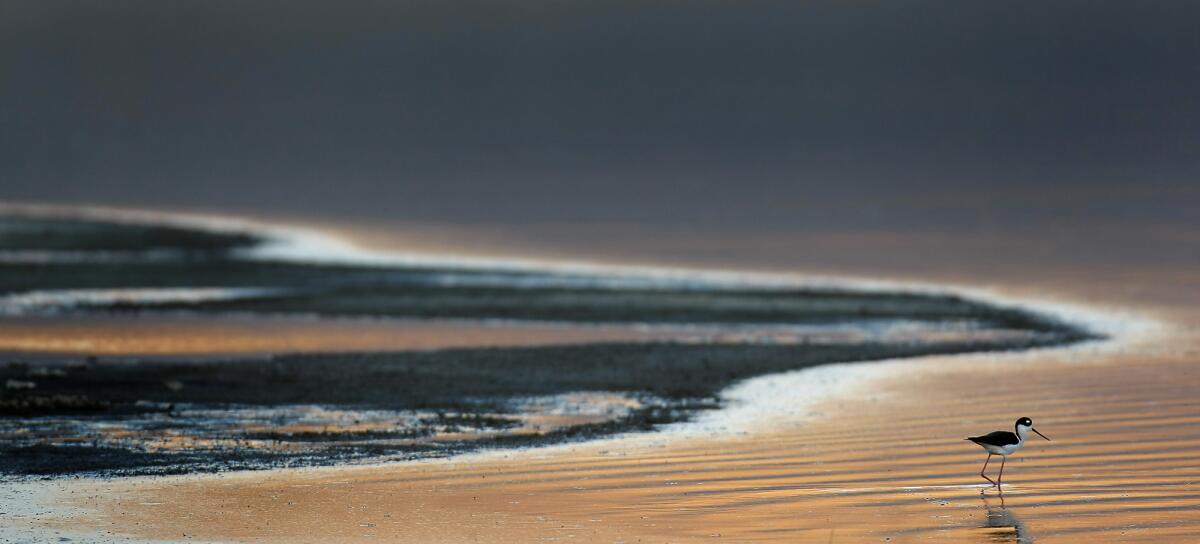Los Angeles may store water under an Owens Valley lake drained to fill its faucets

- Share via
LONE PINE, Calif. — Quick shifts in climate have prompted Los Angeles to consider an unlikely place to bank some of its Sierra Nevada snowmelt: beneath dry Owens Lake, which the city drained starting in 1913 to fill the L.A. Aqueduct and supply a thirsty metropolis.
The Los Angeles Department of Water and Power has launched studies of ambitious plans to store water in the lake’s underground aquifer so that it could be pumped up in summer months and drought years to create pools of water to limit the dust sweeping across the vast lakebed’s salt flats.
The idea, DWP officials said in recent interviews, is to create a drought insurance plan by injecting water from the aqueduct, or percolating runoff in unusually wet years, down into the natural subterranean reservoir they believe is capable of holding up to 250,000 acre-feet of water.

DWP ratepayers have already spent at least $1.4 billion for vegetation, gravel, furrowing and shallow flooding that have reduced dust pollution by more than 99% — the largest dust mitigation effort in the United States. Each year, that project uses about 60,000 acre-feet of water worth about $42 million, officials said.
An acre-foot equals about 326,000 gallons, or enough water to cover a football field one foot deep. An average household annually uses about an acre-foot of water for indoor and outdoor use.
“If the plans work out,” Anselmo Collins, water operations manager for the DWP, said, “we could save between 4,000 and 7,000 acre-feet of water lost to evaporation each year after it is spread on the lake bed to suppress dust.”
The stored water would not be put back into the aqueduct, he said, because it would have been mixed with aquifer water, which is briny and contains elevated levels of naturally occurring contaminants, including arsenic. Collins said the proposed plumbing systems for banking and spreading water at Owens Lake would be based on hydrological and forecast data, as well as abrupt climate shifts such as the unusually heavy 2017 rains that ended the worst five-year drought in recorded California history.
Collins cautioned it will probably take several years to implement one or both water banking strategies.
A century ago, agents from Los Angeles converged on the Owens Valley on a secret mission.
“We have to make sure that pumping groundwater will not adversely affect vegetation, wildlife or wells in the area,” Collins said. “But top climatologists are telling us that changes in infrastructure are needed to prepare for the kinds of climate shifts predicted in their computer models.”

Extreme weather conditions are making it increasingly difficult for Los Angeles to meet state and federal requirements and court settlements in its highly litigated Sierra watershed.
Recent scientific studies point to meteorological trends likely to accelerate in decades to come: Temperatures are warming, Sierra snowpack is getting smaller and melting earlier in the year, and less winter precipitation is arriving as snow in the first place.
The implications stretch from Owens Lake north to Mono Lake, the high-desert water body east of Yosemite National Park best known for its towering, craggy tufa formations. Scientists say climatic shifts are bringing less snowmelt to Mono Lake.
That means if Los Angeles keeps taking its allocated share in the Mono Basin, it could lead to a decline in lake levels, threatening habitat for migrating birds and increasing health risks for those exposed to windblown dust from the receding shoreline, according to the Great Basin Unified Air Pollution Control District.
Phillip Kiddoo, air pollution control officer at Great Basin, expressed cautious optimism about the proposals. “Managing water in the eastern Sierra Nevada concerns me greatly,” he said. “We’ve all learned a hard lesson in this area over the years: All changes are risky and likely to produce unanticipated results.”
Critics say the DWP’s diversions after the turn of the last century helped set the stage for major air pollution problems at Mono Lake and at Owens Lake, about 140 miles to the south.
In the early 1900s city agents posed as ranchers and farmers to buy land and water rights. Then the DWP built dams and diversions that drained Owens Lake and made it all but impossible for the region’s ranchers and farmers to make a living.
Dramatized in the classic 1974 film “Chinatown,” the water grab also transformed local business owners into lessees paying rent to an overbearing landlord 180 miles to the south.
Separately, a new concern is unfolding about 50 miles to the south in the high desert community of Ridgecrest. There, the Indian Wells Valley Groundwater Authority holds the distinction of managing one of the most critically overdrawn groundwater basins in California — and of further depleting the aquifer by yielding to the demands of clients, including local pistachio growers.
Now, the authority is trying to prevent a potential takeover by state water officials, who say the groundwater authority must devise a long-term strategy of sustaining the aquifer in order to comply with state law. To meet that goal, it has proposed that the DWP build a 10-mile spur to divert aqueduct water into its troubled aquifer.
By way of payment for the water banking service, the authority would keep a small portion of the city’s water. In previous interviews, authority officials said a major obstacle standing in the way of such an agreement with the DWP would be the predictable public outcry over the unprecedented giveaway of city water conveyed by its legendary aqueduct.
Collins acknowledged that his agency “was approached by Indian Wells, but there hasn’t been an agreement made or formal proposal presented.”







